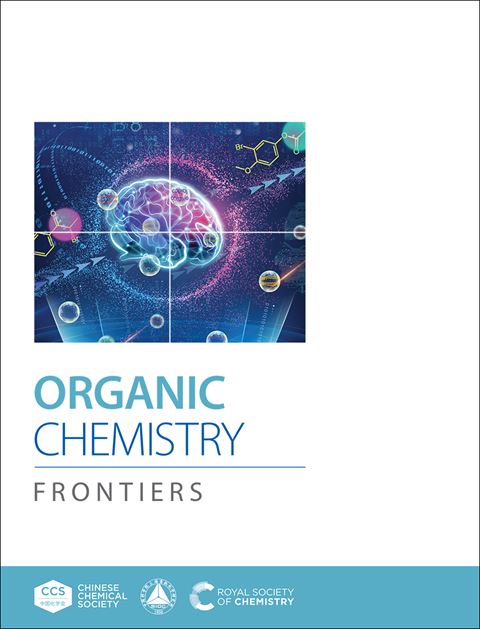铜催化4-羟基二硫代香豆素和4-羟基- 2h -铬-2-硫酮的区域选择性s -烷基化和C-3(H)活化:易于获得4-甲基-3,4-二氢硫代吡喃衍生物†
IF 4.7
1区 化学
Q1 CHEMISTRY, ORGANIC
引用次数: 0
摘要
一种合成4-甲基-3,4-二氢硫吡喃衍生物(3a-p &;以4-羟基二硫代香豆素/4-羟基- 2h -铬-2-硫酮和取代的乙烯醚为原料,在10 mol%的碘化Cu催化剂存在下,在回流条件下在甲苯中合成了6a-o。值得注意的是,4-羟基二硫代香豆素与乙基硫化乙烯(4)的反应也产生了环化产物(5a-e),而4-羟基- 2h -2-硫代铬-2-硫酮与乙基硫化乙烯(4)的反应在相同的反应条件下只产生了氢硫化产物(7a-c)。同样,4-羟基二硫代香豆素与苯基乙烯醚的反应也提供了氢硫化产物(3q-s),而不是在类似反应条件下预期的环化产物。对地层产物进行了DFT计算,建立了反应机理和反应能谱。目前的方法包括通过区域选择性s -烷基化和C-3活化4-羟基二硫代香豆素/4-羟基- 2h -铬-2-硫酮在一个步骤中形成两个新的C-C键和一个C-S键,而代价是一个C-O/C-S键。该方法具有底物范围广、区域选择性高、产率中高、原子经济性高、反应条件温和、反应时间短等优点。本文章由计算机程序翻译,如有差异,请以英文原文为准。
Copper-catalysed regioselective S-alkylation and C-3(H)activation of 4-hydroxydithiocoumarin and 4-hydroxy-2H-chromene-2-thione: Easy access to 4-methyl-3,4-dihydrothiopyran derivatives†
An useful and expedient synthetic route for the synthesis of 4-methyl-3,4-dihydrothiopyran derivatives (3a-p & 6a-o) was accomplished from 4-hydroxydithiocoumarins/4-hydroxy-2H-chromene-2-thione and substituted vinyl ethers in the presence of 10 mol% Cu(I) iodide catalyst in toluene under reflux conditions. Notably, the reaction between 4-hydroxydithiocoumarin and ethyl vinyl sulphide (4) also provided the cyclized products (5a-e), whereas the reaction between 4-hydroxy-2H-chromene-2-thione and ethyl vinyl sulphide (4) gave only the hydrothiolation products (7a-c) under identical reaction conditions. Similarly, the reaction of 4-hydroxydithiocoumarin with phenyl vinyl ether also provided the hydrothiolation products (3q-s) instead of the expected cyclized products under similar reaction conditions. The DFT calculations has been carried out for the formation products to establish reaction mechanisms and reaction energy profiles. The present methodology involves the formation of two new C-C bonds and one C-S bond via regioselective S-alkylation and C-3 activation of 4-hydroxydithiocoumarin/4-hydroxy-2H-chromene-2-thione in a single step at the expense of one C-O/C-S bond. The current procedure possesses several positive features, such as broad substrate scope, high regioselectivity, moderate to good yields, high atom economy, mild reaction conditions, and shorter reaction time.
求助全文
通过发布文献求助,成功后即可免费获取论文全文。
去求助
来源期刊

Organic Chemistry Frontiers
CHEMISTRY, ORGANIC-
CiteScore
7.90
自引率
11.10%
发文量
686
审稿时长
1 months
期刊介绍:
Organic Chemistry Frontiers is an esteemed journal that publishes high-quality research across the field of organic chemistry. It places a significant emphasis on studies that contribute substantially to the field by introducing new or significantly improved protocols and methodologies. The journal covers a wide array of topics which include, but are not limited to, organic synthesis, the development of synthetic methodologies, catalysis, natural products, functional organic materials, supramolecular and macromolecular chemistry, as well as physical and computational organic chemistry.
 求助内容:
求助内容: 应助结果提醒方式:
应助结果提醒方式:


